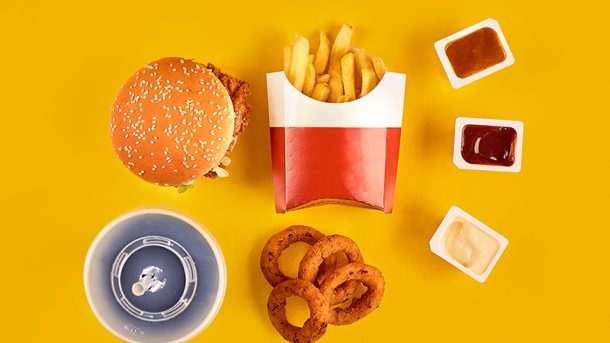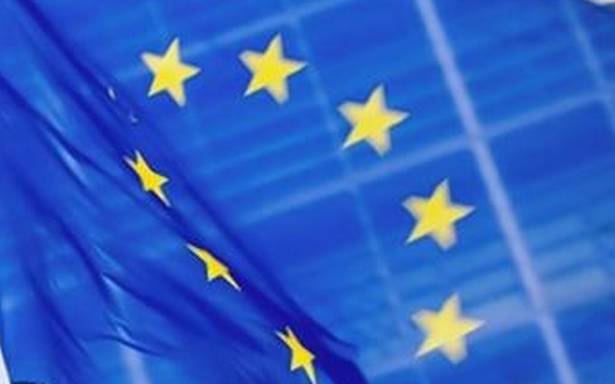Jump to navigation
Photo by Sergey Nazarov/iStock
A raft of new studies have found that certain foods may not be as safe as we think. Organic pasta sauce and ketchup, common medicines and drugs such as Flonase nasal spray, Prozac, and Cipro, and even the basic packaging in which our foods are wrapped were found to be contaminated with a toxic class of chemicals known as per- and polyfluoroalkyl substances, or PFAS. These chemicals are getting into our bodies, our drinking water, our everyday foods—even in some labeled “organic.”
This should matter to all of us. Exposure to these “forever chemicals” (so named because of how long it takes for the chemicals to degrade in nature: forever) has been linked to a wide variety of health conditions such as reduced vaccination response, obesity and diabetes, and an increased risk of autoimmune diseases, cancers, miscarriage, cardiovascular disease, allergies, and asthma. PFAS exposure may even increase the likelihood of COVID-19 infection (and more serious symptoms) and increase cholesterol levels (which is ironic, as PFAS have been discovered in the COVID-19 medicine Paxlovid and cholesterol drugs like Lipitor).
In 2019 I first wrote about PFAS in paper-based food contact materials (wraps and liners, pizza boxes, pastry bags, laminated cake boards, and microwave popcorn bags). Then in 2020 I discovered through an independent lab test that the toxic chemicals were in a brand of menstrual underwear I used.
Now, it seems, we also have to call PFAS “everywhere chemicals.”
They have been found in electronics like cell phone screens, from which you can absorb PFAS through your skin; sleep apnea CPAP machines, from which you can inhale PFAS; and home fertilizers, including compost labeled “organic.” They have also been found in high levels in skincare and cosmetics, beef, some protein powders, canned tuna, fish sticks, and fish from Connecticut, Colorado, Maine, and Michigan. Last year we learned that PFAS are in some milk and vegetables, nonstick products, and products made to be resistant to liquid, grease, and stains. They’re also in climbing ropes, guitar strings, artificial turf, lightbulbs, innocent-looking paper foodware, cake bottoms, bags and boxes, cookware, carpet, car washes, building supplies (glass, paint, sealers for wood, stone, tile, and concrete), printing, petroleum extraction, mining, industrial laundries, and firefighting foams.
How much exposure to PFAS is a “safe” level of exposure? Unfortunately, there is little consensus on the answer. The US EPA has only an advisory safety threshold for two PFAS chemicals (PFOA and PFOS) in drinking water, which is 70 parts per trillion (ppt). Meanwhile, there is still no federal regulation for this huge class of chemicals, which includes over 12,000 by the EPA’s latest estimates. In Europe, in 2020, the European Food Safety Authority proposed a safety threshold for PFAS intake from food, water, and other exposures that entails a much lower limit: no more than 2 ppt (which is also 0.000002 ppm or two nanograms per liter) for four PFAS (PFOA, PFOS, PFNA, and PFHxS). Many organizations rely on what is known as the Denmark standard of 20 ppm. “The standard essentially suggests that no exposure to PFAS from food contact materials is the safest level of exposure: According to the Denmark regulation, paper and board food contact material with less than 20 ppm of total organic fluorine indicates it’s not likely to have been treated with PFAS,” Stine Müller, a project officer for the Danish Consumer Council’s Think Chemicals, a consumer watchdog group, told me.
In the last few months, Mamavation, a consumer watchdog nonprofit now at the vanguard of independent analysis for PFAS, found the chemicals in organic pasta sauce and ketchup. Unfortunately, USDA organic certification does not require farmers to test their soil for PFAS. Farms are now finding that because biosolids (also known as “sewage sludge”) were added to soil before farms became organic, their soil has PFAS and other toxic chemicals. PFAS have been found in edible parts of some produce and in up to 20 million acres of farmland in the United States. But the EPA’s PFAS plan doesn’t address whether the chemicals are present in sludge. It also doesn’t set a deadline to quickly stop industrial PFAS releases—the primary source of sludge contamination, according to the Environmental Working Group. PFAS in food could also be from PFAS in nonstick cookware and food processing equipment.
Here are the brands that Mamavation found either have PFAS or are PFAS-free.
Organic pasta sauce with PFAS
Organic pasta sauce without indications of PFAS
Ketchup with PFAS
Organic ketchup without indications of PFAS
PFAS in paper-like foodware from Whole Foods, other grocers, and fast-food chains
PFAS aren’t only in the foods we buy but also in the packaging used to wrap that food. In April 2022, Consumer Reports found high levels of PFAS even in some using paper labeled as being from “responsible sources,” “EcoCraft,” or “100 percent compostable.” These test results are not representative of all the packaging from a retailer, and the packaging may have changed since Consumer Reports conducted these tests.
Samples below are above the Denmark standard of 20 ppm:
What you can do about it
For too long, these chemicals have been given a free pass to sneak into our bodies and our lives. It’s time for that stop: You can take action both to protect yourself now and to champion policies that force the food, retail, and manufacturing industries to clean up their act.
BYOC (Bring Your Own Containers)
You can also post signs on how California’s 2019 law (A.B. 619) lets you bring your own containers for food providers to fill. The state of Washington encourages businesses to promote reuse through incentives for customers who bring their own foodware. More states should do the same.
Get food from restaurants, meal deliveries, and grocers with reusable to-go foodware that they’ll wash
Wherever you are, there may be options. For example, try Get Naked Lunch to-go and food from other restaurants in Denver and Boulder, Colorado, via EatRepeater. In Chicago and Minneapolis, go truly zero-waste at coffee shops and restaurants served by Forever Ware.
If you’re on the East Coast, New York City has restaurants like Hokey Poke that you can order from via Deliver Zero. Durham, North Carolina, goes green with GreenToGo’s partner bakeries, grocers, and restaurants.
On the West Coast, those in Portland, Oregon, can order from GoBox’s partner restaurants. In the San Francisco Bay Area, if you order food in a Dispatch Goods steel container from its partner restaurants, it’ll even pick up and reuse any freezer-gel packs, insulated Dinnerbell bags, and more from your home. You can also get whole foods with no refined sugar or canola oil in glass that’s organic through Planted Table or vegan and non-vegan options from Plentiful Kitchen, Three Stone Hearth, Vita Kitchen, and Wild Food. For grocers and restaurants in Southern California and Hawai’i, see M’Porte. Or eat at Hawai’i’s Full Cycle Takeout partners.
Canada’s Ontario province has restaurants served by A Friendlier Company. In Toronto, also try restaurants served by Suppli or meal delivery by Crisper. Vancouver has grocers and restaurants using Reusables. And check out more companies listed by Canada Reduces.
Ask businesses to put a paper sign on their front door inviting customers to bring reusables
It’s best to ask the owner in person. Or ask almost without saying a word via friendly form letters from the Remark phone app.
Get money to use reusable dishware and dishwashing services for events or organizations
r.Turn’s r.Ware and r.Cup services are for wherever single-use cups and foodware are used. Vessel Works serves Colorado and California. In Washington, DC, you can apply for grants to support reusable foodware systems. In the San Francisco Bay Area, Sudbusters provides regular and onetime services, Dishjoy provides subscription-based services, and the Clean Water Fund’s ReThink Disposable Program can provide grants or rebates. Northern California’s Sonoma County also gives grants.
If you can’t use reusables, buy single-use foodware certified to have no PFAS or other toxic chemicals
The Biodegradable Products Institute (BPI) offered the first certification using lab testing to verify the absence of PFAS above 100 ppm. GreenScreen Certified Food Service Ware builds on the work that BPI has done and goes further by requiring lab testing for PFAS, plus bisphenols, phthalates, heavy metals, and some solvents. Each ingredient is assessed with the GreenScreen Hazard Assessment tools, which results in the avoidance of thousands of other chemicals of concern. “The GreenScreen Certification process helps companies avoid toxic ‘regrettable substitute’ chemicals and moves the market toward safer chemistry,” Sue Chiang, MPH, MPP, the food program director at the Center for Environmental Health, told me.
Give PFAS manufacturers a pizza your mind
Ask the FDA to ban PFAS in food production, packaging, and manufacturing by joining the Food Chemical Alliance. And ask the EPA to stop manufacturers (like 3M, DuPont, and Chemours) from spewing PFAS into our air, water, and food and to pay to clean up PFAS.
Ask me about more good news, like less-toxic skincare, clothing and fabric, furniture, pesticides, kid’s products, car seats, and strollers!
Like what you read? Sign up for daily updates from Sierra magazine.
Sign up is Processing
Whoops! Something went wrong. Please email webmaster@sierraclub.org
Thanks for signing up for the Green Life email newsletter.
By signing up, you are opting in to receive periodic communications from the Sierra Club.
By day, Jessian Choy, aka “Ms. Green,” co-creates laws and contracts and co-manages SF Approved, a site of green products she helped create at San Francisco Department of Environment. By night, she serves on the board of Earth Island, and shares fun and draconian tricks for a happy, equitable, green world, occasionally via dance videos, mad libs, behavior change, negotiation, and public speaking workshops. Deeper into the night, she petitions dictionaries to be less sexist. Talk nerdy to her here and at @realMsGreen and she might feature you in Sierra’s articles, podcasts, and videos on unicorn solutions.
Ways to Support Sierra
Sign up to receive daily reports about how you can enjoy, explore, and protect the planet.
Thanks for signing up for the Green Life email newsletter.
Subscribe to our magazine by becoming a Sierra Club member today.
Join the conversation on social media.
The national magazine of the Sierra Club
Home | Contact Us | Careers | En Español | Terms and Conditions of Use | Privacy Policy/Your California Privacy Rights | Website Help
Sierra Club® and “Explore, enjoy and protect the planet”® are registered trademarks of the Sierra Club. © 2022 Sierra Club.
The Sierra Club Seal is a registered copyright, service mark, and trademark of the Sierra Club.
By signing up, you are opting in to receive periodic communications from the Sierra Club.
Toxic PFAS, the “Everywhere Chemicals,” Are in Organic Pasta Sauce and Ketchup, Drugs, Pesticides, and Foodware – Sierra Club



